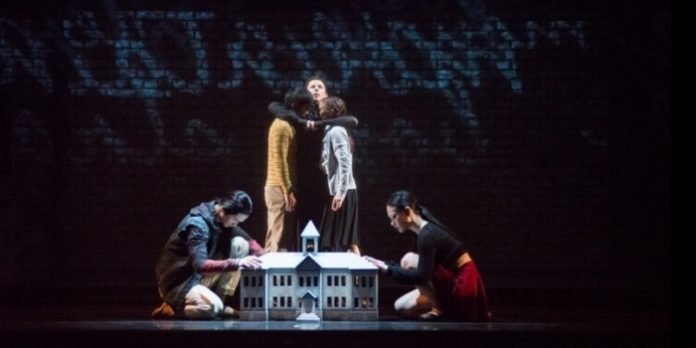The Royal Winnipeg Ballet, Canada’s oldest ballet company, is changing the face of ballet with Going Home Star. Originally created as a part of the closing ceremonies to the Truth and Reconciliation Commission, it tells the story of the First Nations experience of Canada’s residential schools.
If using ballet to tell a First Nations story sounds strange, you aren’t alone.
“Why ballet? Why this bourgeois Western art form to represent First Nations?” Asks Joseph Boyden, the ballet’s author, reflecting on his initial reaction when he was asked to participate. “I had to get around that first and figure that one out. Then I realized what it was is what is more indigenous than dance and music. Human movement to music is a very indigenous thing.”
He also began to see the cross-over of art forms and storytellers (none of the dancers in the Royal Winnipeg Ballet are Aboriginal), as a way to embody reconciliation.
“I realized that we are talking about reconciliation and how it needs to come from all of us, not just this one group. So that began making a lot of sense to me,” he says. “With the idea of ballet, I saw that it is a great way to bring an audience who normally wouldn’t know much or be involved with indigenous aspects of life. We’re going to introduce to a whole new audience this history and that was really important.”
Boyden, a novelist and storyteller of Scottish, Irish, and Anishinaabe heritage, often writes about the experience of Aboriginal peoples in his acclaimed novels, including Three Day Road, Through Black Spruce, and The Orenda, which is currently in talks to be made into a television series.
So how did a novelist who had never attended a professional ballet become the author of one? The connection came from Tina Keeper, who many will remember as the police officer on the television show North of 60. Describing her as “an amazing Cree female activist, politician, and artist”, Keeper was also a producer for Going Home Star.
“She called me one day and said ‘Joseph, we’re creating a ballet for the TRC closing ceremonies and we want you to write it.’”
While Boyden’s response was to say yes immediately, it turns out that had nothing to do with his confidence in participating.
“I said yes without thinking about it, because my wife Amanda, who is also a writer, and I promised each other we would always take challenges and not turn things down that make us uncomfortable. So I said yes and then got off the phone and said, ‘oh no, what have I done?’”

Thus began something of a crash course in ballet. Boyden met and spoke frequently with choreographer Mark Godden, seeing some of his old tapes and discussing his ideas for the piece, as well as watching some of ballet’s old classics. As he immersed himself in the form, he saw how well it could hold this deep story of residential schools.
“Ballets are simple stories on the surface, but you can compare them to the iceberg idea where you only see one tenth of it on the surface but you know there is a great weight holding it up that you can’t see. That’s the case in all these old stories, Swan Lake, for example. I realized that the story of residential schools is this huge and heavy and important story like that.”
The story itself is contemporary and ultimately redemptive, which was very important to Boyden.
“I don’t want to paint just the bleak picture even though it’s a very tough topic to tackle,” he says. “I didn’t want to do a historical setting. I wanted to be of the here and now, when reconciliation is going to happen.”.
The ballet’s story follows a contemporary indigenous woman who is a hair dresser by day and a party girl by night. She encounters a street person who, as Boyden says, “appears to be your average Aboriginal street person, but he’s not, he’s the Trickster and he introduces her to the underworld and back into history.”
It was the creation of these two characters, as well as two “mirror” characters in the underworld, a girl and a boy at a residential school, that created the foundation for the story. Each of the characters represents one of the Four Directions, a concept that is very important to many Aboriginal traditions. “When I had that, I knew I had created the story,” says Boyden.
From there, Boyden had his first experience of collaboration by letting his story get taken on by other artists. The result?
“I am awestruck by what they’ve done with it, I think it’s brilliant. I was just one small part, I gave them a story and they turned it into something magical on stage. It’s heart-wrenching it’s beautiful, the dancers are extraordinary,” he says. “The music by Christos Hatzis is just brilliant. Mark Godden’s choreography is really compelling, you can’t take your eye off of it, and the set design from KC Adams is amazing. Overall, it’s just something that is beautiful to witness. And tough. It’s tough but beautiful, and ultimately redemptive.”
Going Home Star plays the Queen Elizabeth Theatre April 7 – 9. Visit https://rwb.org for tickets and information.

